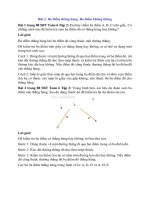Economic growth and economic development 47
Bạn đang xem bản rút gọn của tài liệu. Xem và tải ngay bản đầy đủ của tài liệu tại đây (95.47 KB, 1 trang )
Introduction to Modern Economic Growth
Much of the data used in this chapter comes from Summers-Heston’s Penn World
tables (latest version, Summers, Heston and Aten, 2005). These tables are the result of a very careful study by Robert Summers and Alan Heston to construct
internationally comparable price indices and internationally comparable estimates
of income per capita and consumption. PPP adjustment is made possible by these
data. Summers and Heston (1991) give a very lucid discussion of the methodology
for PPP adjustment and its use in the Penn World tables. PPP adjustment enables
us to construct measures of income per capita that are comparable across countries. Without PPP adjustment, differences in income per capita across countries
can be computed using the current exchange rate or some fundamental exchangerate. There are many problems with such exchange-rate-based measures. The most
important one is that they do not make an allowance for the fact that relative prices
and even the overall price level differ markedly across countries. PPP-adjustment
brings us much closer to differences in “real income” and “real consumption”. Information on “workers” (active population), consumption and investment are also
from this dataset. GDP, consumption and investment data from the Penn World
tables are expressed in 1996 constant US dollars. Life expectancy data are from the
World Bank’s World Development Indicators CD-ROM, and refer to the average
life expectancy of males and females at birth. This dataset also contains a range of
other useful information. Schooling data are from Barro and Lee’s (2002) dataset,
which contains internationally comparable information on years of schooling.
In all figures and regressions, growth rates are computed as geometric averages.
In particular, the geometric average growth rate of variable y between date t and
t + T is defined as
gt,t+T
à
yt+T
yt
ả1/T
1.
Geometric average growth rate is more appropriate to use in the context of income
per capita than the arithmetic average, since the growth rate refers to “proportional
growth”. It can be easily verified from this formula that if yt+1 = (1 + g) yt for all
t, then gt+T = g.
Historical data are from various works by Angus Maddison (2001, 2005). While
these data are not as reliable as the estimates from the Penn World tables, the
33









